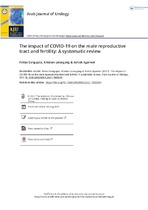| dc.description.abstract | Objective: The COVID-19 pandemic, caused by the acute respiratory syndrome-coronavirus 2
(SARS-CoV-2), remains an ongoing public health challenge. Although males are affected slightly more
than females, the impact of SARS-COV-2 on male reproductive system remains unclear. This systematic
review aims to provide a concise update on the effects of COVID-19 on male reproductive health,
including the presence of viral RNA in semen, and the impact on semen quality, testicular
histology, testicular pain and male reproductive hormones. The global health is fronting an
immediate as well as impending threat from the novel coronavirus (SARS- CoV-2) causing coronavirus
disease (COVID-19), that inflicts more males than females. Evidence suggest that male reproductive
system is susceptible to this viral infection. However, there are still several pertinent queries
that remain to be fully explained regarding the mechanism in testicular SARS-CoV-2 dynamics and the
exact mode of its actions. Thus, the present systematic review aims to provide a concise update on
the effects of coronavirus disease 2019 (COVID-19) on male reproduction.
Methods: A systematic review was conducted according to Preferred Reporting Items for Systematic
Reviews and Meta-Analyses guidelines searching the PubMed database. Eligibility for inclusion were
original human studies evaluating the impact of COVID-19 on male repro- ductive health. Specific
outcomes required for inclusion were at least one of the following: i) seminal detection of mRNA
virus, or evaluation of ii) semen analysis, iii) testicular histology or ultrasonography, iv)
testicular clinical symptoms and/or v) male reproductive hormones in COVID-19-positive patients.
Results: Of 553 retrieved articles, 25 met the inclusion criteria. This included studies primarily
investigating the presence of viral RNA in semen (n = 12), semen quality (n = 2), testicular
histology (n = 5), testicular pain (n = 2) and male reproductive hormones (n= 4).
Results show little evidence for the presence of viral RNA in semen, although COVID-19 seems to affect seminal parameters, induce orchitis, and cause hypogonadism. Mortality cases suggest severe histological disruption of testicular architecture, probably due to a systemic and local reproductive tract inflammatory response and oxidative stress-induced damage.
Conclusions: Clinical evaluation of the male reproductive tract, seminal parameters and
reproductive hormones is recommended in patients with current or a history of COVID-19,y treatment. Any long-term negative impact on male reproduction remains unexplored and an important future consideration. | en_US |

